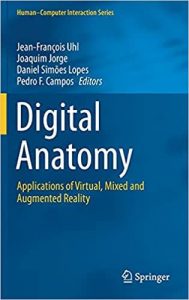
Digital Anatomy: Applications of Virtual, Mixed and Augmented Reality
New book brings together 2 INESC-ID researchers: Joaquim Jorge and Daniel Lopes and other specialists in a unique interdisciplinary work

The first book on digital anatomy, written in close cooperation between doctors, anatomists, and computer scientists, addresses Extended Reality applied to Clinical and Surgical Practice through Training and Teaching.
The book just published by Springer / Nature’s prestigious series of books “Human-Computer Interaction Studies”, edited by two INESC-ID/Tecnico Professors, Joaquim Jorge and Daniel Lopes of Department of Computer Engineering and INESC-ID / Lisbon, in collaboration with Professors Jean-François Uhl of the University Paris-Descartes and Pedro Campos (University of Madeira). The book clarifies the classic approaches with VR, AR, and MR; It presents recent VR, AR, MR systems, techniques, and methods for digital anatomy.
This book offers readers new insights into extended reality to digital anatomy, a new emerging discipline. The way teachers teach anatomy in the classroom is changing rapidly as new technology-based approaches become increasingly accessible. Recent studies show that Virtual (VR), Augmented (AR), and Mixed-Reality (MR) can improve retention andlearning outcomes.
“The book is aimed at the scientific, academic and professional research community. It can be used as a textbook, “survey” on the state of the art and seed for new research projects”, says Joaquim Jorge, one of the authors and researcher at INESC-ID.
Readers will find relevant tutorials on three-dimensional reconstruction techniques to perform virtual dissections. Several chapters serve as practical manuals for students and trainers in anatomy to update or develop their digital anatomy skills. We developed this book as a support tool for collaborative efforts around Digital Anatomy, especially in international and interdisciplinary distance-learning contexts. Our goal is to leverage the source material in this book to support new digital anatomy courses and programs in interdepartmental and interdisciplinary collaborations.
A work carried out by several hands that resulted in an unusual book that brings together specialists in Anatomy, Informatics and Medicine.
“The idea came from a collaboration with my colleague Jean-François Uhl that I had the opportunity to meet at a congress organized in Lisbon”, says Joaquim Jorge. “Me and my colleague Jean-françois Uhl were instrumental in exercising the network of contacts that each one of us has in their respective fields and collecting chapters. Daniel Lopes and Pedro Campos helped to recruit reviews and in the process of writing and editing some chapters ”, adds the researcher.
Joaquim Jorge also tells us how the idea for this book was born:
“This book came from an idea of mine. I organized the proposal given the experience of writing and editing books for Springer / Nature (it is already the 4th). The proposal was drawn up in 2018 and accepted in 2019. In 2019/2020 we have collected chapters around the world and 2020/2021 were spent on reviewing and reviewing chapters (where Daniel and Pedro Campos helped a lot). The book came out after a seven-month marathon (I planned to finish it on my sabbatical, but the pandemic delayed the process”.
The book was just launched and more information can be found at https://www.springer.com/gp/book/9783030619046
“I am very happy with the range of knowledge, skills and approaches that we have gathered in this book, with contributions of great technical level and thematic diversity, which I hope will stimulate / catalyze new lines of research and teaching”, pointed out Joaquim Jorge
